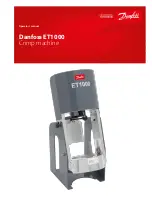
Yost Vises
388 W. 24th St.
Holland MI 49423
Yost 904-AS
Contact:
www.yostvises.com
616.396.2063 Customer Service
If there is any question about a condition being safe or unsafe, do not operate the vise.
To avoid risk of personal injury, equipment damage, fire & shock, make sure work area has the following condi-
tions:
•
Floor is dry. Damp, wet or rainy conditions can cause operator to slip.
•
Operator must be of sufficient age to operate vise in a safe condition.
•
Well Lit.
•
Clean and unobstructed.
•
Workbench is properly secured to floor or wall.
•
Workbench is designed sufficiently to handle vise and work load (torque placed upon the vise and
workbench).
Mount Vise To A Secure Workbench
1.
Place vise on the workbench to identify location of mounting holes.
2.
For added strength to the workbench prior to installing and securing vise, reinforce the workbench
with additional wood or metal plates. Failure to mount the vise to a sturdy table can result in injury.
3.
Mark and drill holes through the workbench and wood / metal plate using the swivel base as the
template for the mounting holes. Prior to drilling, make sure area is free & clear of any hazards.
4.
Install proper length & diameter bolts into the swivel base of the vise. Yost recommends at the
minimum the following configuration:
Install proper length & diameter bolts along with flat washer through the swivel base of the vise. The
bolt should be long enough to protrude at least 1” beyond, the underside of the workbench and wood /
metal plate. On the underside of the workbench and wood / metal plate, place a flat washer, lock washer and
locking nut to the bolt. Securely tighten vise to the workbench. Periodically, recheck and re-tighten the nuts.
Vise Operation
Make sure vise selection (size and type) is appropriate for use and application. Larger vises are readily avail-
able through Yost Vises. Never force or use cheater bars, pipe extensions on the screw handle of the vise as
this places excessive pressure on the vise components and they may fail resulting in severe bodily injury.
Step 1: Make sure vise is securely mounted to the workbench.
Step 2: Make sure the swivel base lockdowns are secure.
Step 3: Open the vise by turning the vise handle counterclockwise. Do not open beyond the vises rated
capacity (jaw opening).
Step 4: Place item between the serrated jaws of the vise.
Step 5: Close the vise by turning the vise handle clockwise until the item is snug between the serrated jaws.






















